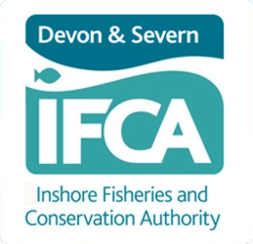Cockles
Page review/updated 13/05/2025
(Content of page last updated: 13th May 2025)
COCKLES IN D&S IFCA’S DISTRICT
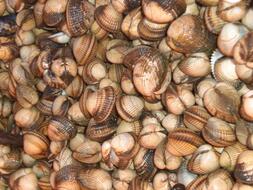
Cockles, Cerastoderma edule, are burrowing filter feeding bivalves which grow up to 5cm long. They are usually found in soft to coarse muddy sediment to a depth range of around 5cm in the mid to lower intertidal area and can, less frequently, be found subtidally. They are highly tolerant to fluctuating salinities and as such can be frequently found in estuaries and sheltered bays. D&S IFCA conducts surveys of cockle populations in three estuaries within its District: the Teign, Exe and Taw-Torridge. The cockle surveys are conducted to monitor population changes, both in density and distribution. These data can then be used to inform any appropriate management decisions relevant to the estuary in question.
COCKLE STOCK SURVEY METHODOLOGY
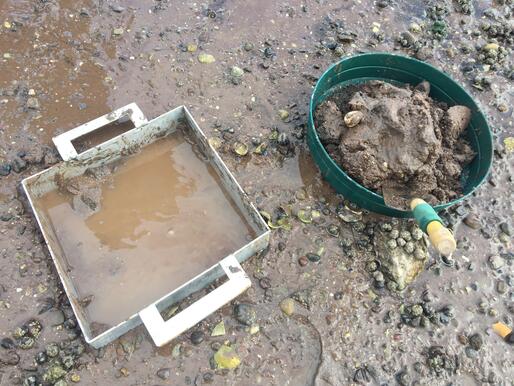
Although there is some minor variance in the survey techniques between the estuaries, the main methodology remains the same. A grid, comprised of different stations set equal distance apart, is placed over the survey area and co-ordinates generated for each station. In the Exe Estuary the distance between stations is 115m x 115m whilst in the Teign Estuary it is 75.5m x 75.5m and the Taw Torridge Estuary is 93m x 93m. This difference in grid size reflects the necessary trade-off in sampling intensity and coverage of available area at each site with limited staff resources. Officers navigate via GPS to the location of each station and randomly throw a 0.1 (metre squared) quadrat within a 10m radius. The contents of the quadrat will then be dug out (to a depth of approximately 6cm), sieved, and then any live cockles found are grouped to station level and collected for later analysis. Inaccessible sites, and sites with no live cockles are noted. To ensure that the data collected are comparable between years for a given estuary, the same stations and co-ordinates are used every year.
When the survey of the beds is complete the length and width of all cockles are measured using callipers. After measuring, the cockles are then sorted into age classes by determining how many annual growth rings are present on the shell (one per winter) e.g. 0 rings = current year, 1 ring = 1st winter /1 year, 2 rings = second winter/ 2 years and so on. Each year group from that station is then weighed separately (to the nearest 1g) and recorded. This is repeated for all station samples and once finished all the cockles are returned to the estuary. Based on the data collected it is possible to determine how many cockles are present per 1m2 per station across the survey area, as well as providing length frequency, recruitment, and mortality data for the surveyed population. Whilst it would be preferable to take multiple samples per station, the limits of intertidal surveying mean that D&S IFCA Officers only have a brief four-hour window to work with over the spring low water tide. Data collection, therefore, needs to be both efficient and effective, the described method is employed widely amongst other IFCAs and is regarded as the appropriate methodology.
EXE ESTUARY
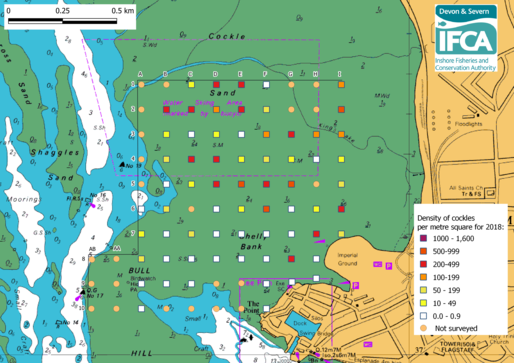
D&S IFCA began carrying out annual cockle stock assessments in 2010 on the Cockle Sands near Exmouth, in the Exe Estuary, to determine if a sustainable cockle fishery was viable. Two MSc students, from the University of Plymouth and University of the West of England, looked at the effects of harvesting cockles using an elevator harvester on macrofauna, cockle populations and sediment parameters within the Exe Estuary. This form of harvesting was found to be low impact and as a result of undertaking this research and the subsequently completed Habitat Regulation Assessment, Natural England advised that the fishery could continue. However, there was a mass mortality event of cockles in 2011, which was caused by elevated levels of two parasites that affect the cockle’s abductor muscle and preventing closure of the shell, leading to death. As a result, the fishery could not continue. Due to the lack of a viable cockle fishery on the Exe the Cockle Sands bed was declassified as a harvesting area and there are currently no classified harvesting areas for cockles on the Exe Estuary.
A further mortality event is thought to have occurred in 2014 after the winter storms (which occurred between mid-December 2013 through to mid-February 2014), resulting in depleted oxygen levels causing estuary-wide morality of all shellfish in the intertidal. These storms caused a significant loss of mussels from Bull Hill (near Cockle Sands). Despite these storms, and the corresponding loss of other bivalves (e.g. mussels) from the area, cockle densities do not seem to have been affected as dramatically as adult cockle density on the estuary seems to have been relatively stable between 2014-2024. Although it is not possible to statistically test the variation in density of juvenile cockles, there appears to be some years with strong recruitment, particularly 2014, 2016 and 2018. Despite a lack of a commercial fishery, a low level of hand gathering has and still occurs on the Cockle Sands bed. D&S IFCA continued to conduct cockle surveys annually up until 2018, monitoring the beds for recovery and using the data to inform future management within the Exe Estuary SPA particularly in relation to hand gathering. Cockle surveys are now being conducted every two years.
Exe Estuary Stock Assessment Reports:
A collection of older reports can be found in Section H (Mollusca/Cockles) of the Resource Library.
TEIGN ESTUARY
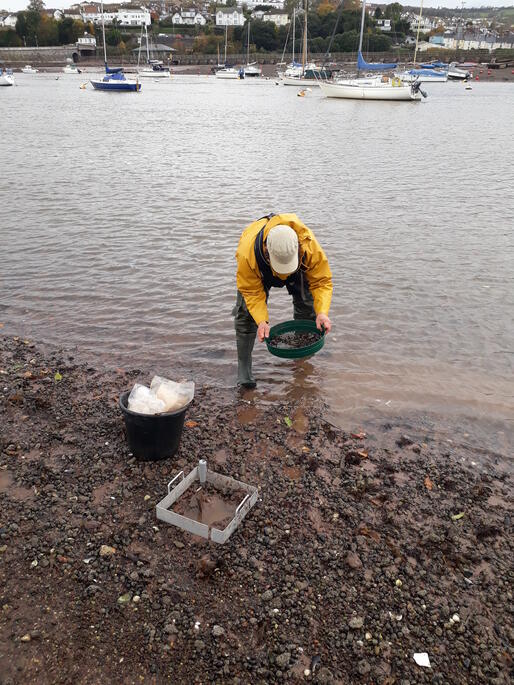
Cockles are present within the Teign Estuary and have known to be collected at low levels, both historically and up to the present day. There are currently no marine conservation designations in the Estuary, although overwintering birds such as oystercatchers are known to frequent the estuary and feed on the mussels and cockles found on the intertidal beds. The cockle populations within the Teign Estuary are important and concerns about their removal and the potential for over-exploitation by recreational fishers, particularly from The Salty intertidal bank downstream of the Shaldon Bridge, have been documented as far back as 2008.
D&S IFCA understands the local community and ecological importance of cockles within The Salty and surveys have been conducted annually between 2018-2020 and every two years since. These surveys will assist with monitoring the cockle stock in the Teign Estuary and may inform future development of a D&S hand Working Permit Byelaw. D&S IFCA Officers have recently combined D&S IFCA’s survey data with semi-quantitative anecdotal information from stakeholders on the Teign, conducting an analysis to understand whether current levels of hand gathering are impacting upon adult cockle populations.
Information supplied to D&S IFCA indicated specific areas where hand-gathering is taking place either side of Shaldon Bridge and in the middle of the Salty. These areas overlap with some of D&S IFCA’s current survey stations, allowing for initial statistical analysis of cockle densities in harvested versus non-harvested areas, though it is important to note that the anecdotal information on hand-gathering has not been independently verified by D&S IFCA’s Officers. Results from the statistical analyses indicate that at the current level of effort, cockle gathering does not appear to be having an impact on the density of adult cockles. Whilst there is a temporary closure of shellfish beds in the Teign, this only applies to mussel. There are currently no D&S IFCA Byelaws that manage the collection of cockles from estuaries within D&S IFCA’s District. This is explored in more detail in D&S IFCA’s 2024 cockle stock assessment for the Teign, which can read by using the link below.
Teign Estuary Stock Assessment Reports:
A collection of older reports can be found in Section H (Mollusca/Cockles) of the Resource Library.
TAW TORRIDGE ESTUARY
Although cockles are present within the estuary, the stock has never reached a large enough level to be harvested commercially. Low level recreational gathering is known to occur both historically and to the present day. The estuary is an important site for wildlife and has been designated a Site of Special Scientific Interest (SSSI) for over-wintering and migratory populations of wading birds. D&S IFCA understands the environmental, social and economic importance of these beds and surveys were conducted for the first time in 2022. The biomass of cockles estimated as a result of these surveys is used in a shellfish ecological requirement model provided by Natural England, which allows an estimate to be made of the ecological (food) requirements of wading birds feeding on shellfish within the estuary.
There appears to have been a decline in both adult and juvenile density of cockles since surveys began as well as a decrease in total tonnage. However, it is important to note that the currently available survey data may not give an accurate understanding of the cockle beds on the Taw Torridge, with sufficient resolution to reliably detect trends. This will be attempted with additional years of future survey data. Observing the long-term population trends is vital to understand the population dynamics of any given cockle population.
Although there is currently no commercial fishery for cockles on the Taw Torridge Estuary, surveys will continue to be carried out annually in order to monitor the cockle stocks on the estuary, with data being used as part of the annual assessment of the shellfish available for use as prey resource by the overwintering birds on the Taw Torridge SSSI. The most recent survey reports can be found below.
Taw Torridge Stock Assessment Reports:
AVON ESTUARY
Given the designation of the Devon Avon MCZ and anecdotal reports of cockle beds on the estuary, D&S IFCA aimed to establish a baseline of cockle stocks on the estuary in 2020. Three locations were surveyed, including along the shore below Bantham Village, Cockleridge and Villa Crusoe (Figure 3). Only 8 cockles were found in total, so no analyses were completed in 2020. D&S IFCA officers liaised with some hand gatherers collecting cockles for personal consumption, who reported that they had not found many cockles in the estuary and there seem to be less now than previously recorded. Due to the apparent lack of cockles present in the Devon Avon Estuary, surveys have not been undertaken since the initial visit in 2020.
End.
